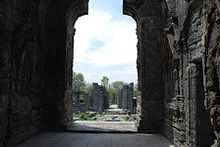Martand Sun Temple
Coordinates: 33°44′46″N 75°13′12″E / 33.746°N 75.220°E
Martand Sun Temple was dedicated to Surya (Sun) god and is now in ruins. The ruins of the temple are located near Anantnag in Indian state of Jammu and Kashmir.[1] Martand is another Sanskrit name for Hindu Sun-god.
The Martand temple is one of the important archaeological sites of the country. It was built around 500 AD. The Martand temple (coordinates 33°44′44″N 75°13′13″E / 33.7456817°N 75.2203792°E) or 33.7456817°N and 75.2203792°E is situated at Kehribal, 9 km east-north-east of Anantnag and south of Mattan.
History
The Martand Sun Temple was built by King of Karkota Dynasty - Lalitaditya Muktapida in 8th century AD.[2][3]It is said to have been built during 725-756 AD.[4]The foundation of the temple is said to have been around 370-500 AD., and also some attributed the construction of the temple began with Ranaditya.[5][6]
The temple was completely destroyed by Sikandar Butshikan in early 15th century. It took one year for Sikander Butshikan to fully damage and destroy this Martand temple. [7][8]
Architecture and style
The temple was built on top of a plateau from where one can view whole of Kashmir Valley. From the ruins and archeological findings, one can say it was an excellent specimen of Kashmir style of architecture, which had blended the Gandharan, Gupta, Chinese, Roman, Syrian-Byzantine and Greek forms of architecture.[9][10] This beautiful Martand temple has a colonnaded courtyard, with the shrine in its center, which is 220 feet long and 142 feet broad. It was surrounded by 84 small shrines.[11]


Present status

The Martand temple is one of the important archaeological sites of the country. Even today one gets surprised over art and skill of the builders of this world famous Martand temple by looking at its ruins.[12]The government of India, after independence has developed the site as an important tourist site with facilities.
Site of national importance
The archeological survey of India has declared the Martand Sun Temple as a site of national importance in Jammu and Kashmir.[13] The temple appears in the list of centrally protected monuments as Kartanda(Sun Temple).[14]

References
- ↑ Kamlesh Moza. "Prominent Holy Places in Kashmir".
- ↑ Animals in stone: Indian mammals sculptured through time By Alexandra Anna Enrica van der Geer. pp. Ixx.
- ↑ India-Pakistan Relations with Special Reference to Kashmir By Kulwant Rai Gupta. p. 35.
- ↑ The Early Wooden Temples of Chamba. pp. 50,66.
- ↑ "Tourist places in south Kashmir". alpineinpahalgam.com. Retrieved 8 July 2012.
- ↑ "Martand House of Pandavs". Search Kashmir. Retrieved 11 July 2012.
- ↑ Hindu temples were felled to the ground and for one year a large establishment was maintained for the demolition of the grand Martand temple. But when the massive masonry resisted all efforts, fire was applied and the noble buildings cruelly defaced.-Firishta, Muhammad Qãsim Hindû Shãh; John Briggs (translator) (1829–1981 Reprint). Tãrîkh-i-Firishta (History of the Rise of the Mahomedan Power in India). New Delhi
- ↑ India: A History. Revised and Updated By John Keay.
- ↑ Al-Hind, the Making of the Indo-Islamic World, Volume 1 By André Wink. 1991. pp. 250–51.
- ↑ Arts Of India By Krishna Chaitanya. p. 7.
- ↑ Encyclopædia Britannica: a new survey of universal knowledge: Volume 12, pp:965
- ↑ http://www.kashmir-information.com/ConvertedKashmir/Chapter10.html
- ↑ "Archeological survey of India protected momuments". heritageofkashmir.org. Retrieved 11 August 2012.
- ↑ "Protected monuments in Jammu & Kashmir". asi.nic.in, Archeological surey of india. Retrieved 29 October 2012.
External links
| Wikimedia Commons has media related to Sun Temple, Martand. |
- Indira Gandhi National Centre for the Arts - Martand Sun Temple Site Photos
- Martand Sun Temple in winter - Pics of Surya Sun Temple under snow
- Martand Sun Temple and around
| |||||
